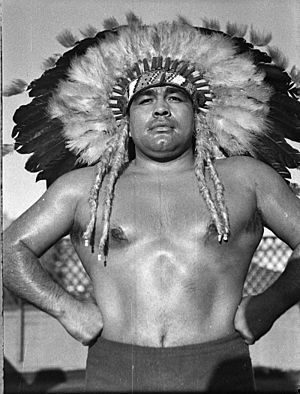Chief Little Wolf facts for kids
Quick facts for kids Chief Little Wolf |
|
|---|---|

Chief Little Wolf, Sydney, 1937.
|
|
| Born | November 25, 1911 Hoehne, Colorado, United States |
| Died | November 13, 1984 (aged 72) Seattle, Washington, United States |
| Professional wrestling career | |
| Ring name(s) | Benny Tenario Ben Tenario Big Chief Little Wolf Chief Little Wolf |
| Billed height | 5 ft 9 in (175 cm) |
| Billed weight | 244 lb (111 kg) |
| Trained by | Count Zaremba |
| Debut | 1928 |
| Retired | 1958 |
Ventura Tenario (born November 25, 1911 – died November 13, 1984) was an American professional wrestler. He was much better known by his wrestling name, Chief Little Wolf. He spent a lot of his wrestling career in Australia and New Zealand, where he became very popular.
Contents
Early Life and Family
Ventura Tenario was born in Hoehne, Colorado, on November 25, 1911. He was the second of four children. His parents were Jose and Maria Tenario.
He was married three times during his life. His third wife was Audrey Lillis "Dona" Corner. They had a daughter named Markeeta.
Markeeta Little Wolf
Markeeta was born in Christchurch, New Zealand, in 1958. By the time she was 16, she was a pop star in Australia!
Later, she moved to the USA. She tried to become a music star and movie actress in Hollywood, but it didn't work out. So, she started working in real estate. She moved to Waitsburg, Washington. There, she became involved in local politics. She joined the City Council and served three times as the city's Mayor.
Chief Lone Wolf
Ventura's brother, Ernesto Tenario, also became a professional wrestler. He was known by the name "Chief Lone Wolf".
Military Service
Ventura Tenario joined the United States Army in May 1943. He served until January 1945 during World War II. He was part of the war efforts in Europe.
His Amazing Wrestling Career
Chief Little Wolf had a long wrestling career from 1932 to 1958. He fought in over 1,100 matches! He won 501 of them, had 178 draws (ties), and lost 357. He wrestled against many famous opponents.
In 1946, after serving in the war, he broke his leg badly during a match in Chicago. For a while, people thought he might never wrestle again. But he did!
Wrestling in the United States
In 1935, Chief Little Wolf was set to challenge the heavyweight champion, Jim Londos. Londos didn't show up for the match, so he was suspended in several states.
Later that year, on July 8, 1935, Chief Little Wolf wrestled against Daniel "Danno" O'Mahoney at Yankee Stadium in New York. This was a big heavyweight title match. O'Mahoney won the match after about 28 minutes.
Becoming a Star in Australia and New Zealand
Chief Little Wolf arrived in Auckland, New Zealand, in June 1937. He quickly became a popular wrestler there.
When he first wrestled in Australia in August 1937, the newspapers said he was ranked as the third-best heavyweight wrestler in the world!
A wrestling writer in 1947 noted that Chief Little Wolf could take a lot of hits and keep fighting. He also had amazing strength and energy. From 1937 to 1958, he wrestled over a thousand times in Australia.
Besides his stadium matches, he also had a traveling tent-show. In this show, he would demonstrate wrestling moves, tell stories, and perform horse-riding tricks. He toured almost all of Australia with this show. In 1953, he even claimed that 75% of Australians had seen him perform!
His last match in Australia was in November 1956. He teamed up with "Great Zorro" in a tag-team match and they won.
Retirement from Wrestling
After his time in Australia, he wrestled two more times in the USA in 1957.
In 1958, Ventura Tenario had a serious stroke. This affected one side of his body and face. He had to retire from wrestling and never worked again. He lived in a special hospital in Australia for many years before returning to the United States in 1980.
An Australian Folk Hero
Chief Little Wolf became a true folk hero in Australia. A researcher named Barry York wrote an article about him in 1998. He asked the public for stories about the Chief and received over 700 letters!
These letters showed how much people loved and admired him. They saw him as someone who came from humble beginnings but never forgot the common people. He was known for being very kind and generous, always helping others. People believed he had superhuman qualities because of his amazing wrestling skills. His sudden and sad retirement also added to his legend. He was seen as an "acceptable outsider" – a friendly foreigner who was loved by everyone.
The Leichhardt Stadium Incident
In 1940, during a wrestling match in Australia, Chief Little Wolf was thrown out of the ring by his opponent, Terry McGinnis. McGinnis then attacked the referee and was disqualified.
After this, a radio commentator named Captain Tom Bairnsfather sued Chief Little Wolf and the stadium. He claimed he was injured when Chief Little Wolf was thrown from the ring. Chief Little Wolf said he was protected by his contract. The lawsuit eventually faded away.
Championships and Awards
- National Wrestling Alliance
- NWA Rocky Mountain Heavyweight Championship (1 time: 1948).
- New York's Wrestling Hall of Fame
- He was inducted into the Hall of Fame in 1974.
Movie Mix-Up
Some people mistakenly believe that Chief Little Wolf appeared in two movies: Bone Crushers (1933) and We're in the Money (1935). However, the person in those movies was actually another wrestler named Myron Cox.
Death
Ventura Tenario passed away in Seattle, Washington, on November 13, 1984. His body was cremated.
Images for kids









